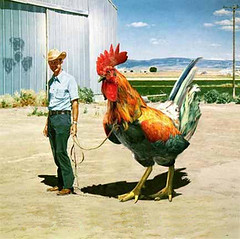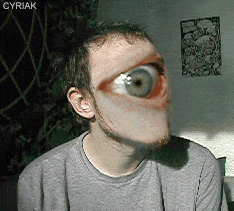Like Music for My Ears
"Dada or Dadaism [French, from dada, child's word for a horse] Nihilistic movement in the arts that flourished chiefly in France, Switzerland, and Germany from about 1916 to about 1920 [and later -ed.] and that was based on the principles of deliberate irrationality, anarchy, and cynicism and the rejection of laws of beauty and social organization.
The most widely accepted account of the movement's naming concerns a meeting held in 1916 at Hugo Ball's Cabaret (Café) Voltaire in Zürich, during which a paper knife inserted into a French-German dictionary pointed to the word dada; this word was seized upon by the group as appropriate for their anti-aesthetic creations and protest activities, which were engendered by disgust for bourgeois values and despair over World War I.
In the United States the movement was centered in New York at Alfred Stieglitz's gallery, '291,' and at the studio of the Walter Arensbergs. Dada-like activities, arising independently but paralleling those in Zürich, were engaged in by such chiefly visual artists as Man Ray and Francis Picabia. Both through their art and through such publications as The Blind Man, Rongwrong, and New York Dada, the artists attempted to demolish current aesthetic standards. Traveling between the United States and Europe, Picabia became a link between the Dada groups in New York City, Zürich, and Paris; his Dada periodical, 291, was published in Barcelona, New York City, Zürich, and Paris from 1917 through 1924.
In 1917 the Dada movement was transmitted to Berlin, where it took on a more political character. The Berlin artists, too, issued Dada publications: Club Dada, Der Dada, Jedermann sein eigner Fussball ('Everyman His Own Football'), and Dada Almanach.
In Paris Dada took on a literary emphasis under one of its founders, the poet Tristan Tzara. Most notable among Dada pamphlets and reviews was Littérature (published 1919-24), which contained writings by André Breton, Louis Aragon, Philippe Soupault, and Paul Éluard. After 1922, however, Dada faded and many Dadaists grew interested in surrealism."
DaDa Online
The most widely accepted account of the movement's naming concerns a meeting held in 1916 at Hugo Ball's Cabaret (Café) Voltaire in Zürich, during which a paper knife inserted into a French-German dictionary pointed to the word dada; this word was seized upon by the group as appropriate for their anti-aesthetic creations and protest activities, which were engendered by disgust for bourgeois values and despair over World War I.
In the United States the movement was centered in New York at Alfred Stieglitz's gallery, '291,' and at the studio of the Walter Arensbergs. Dada-like activities, arising independently but paralleling those in Zürich, were engaged in by such chiefly visual artists as Man Ray and Francis Picabia. Both through their art and through such publications as The Blind Man, Rongwrong, and New York Dada, the artists attempted to demolish current aesthetic standards. Traveling between the United States and Europe, Picabia became a link between the Dada groups in New York City, Zürich, and Paris; his Dada periodical, 291, was published in Barcelona, New York City, Zürich, and Paris from 1917 through 1924.
In 1917 the Dada movement was transmitted to Berlin, where it took on a more political character. The Berlin artists, too, issued Dada publications: Club Dada, Der Dada, Jedermann sein eigner Fussball ('Everyman His Own Football'), and Dada Almanach.
In Paris Dada took on a literary emphasis under one of its founders, the poet Tristan Tzara. Most notable among Dada pamphlets and reviews was Littérature (published 1919-24), which contained writings by André Breton, Louis Aragon, Philippe Soupault, and Paul Éluard. After 1922, however, Dada faded and many Dadaists grew interested in surrealism."
DaDa Online










0 Comments:
Post a Comment
<< Home